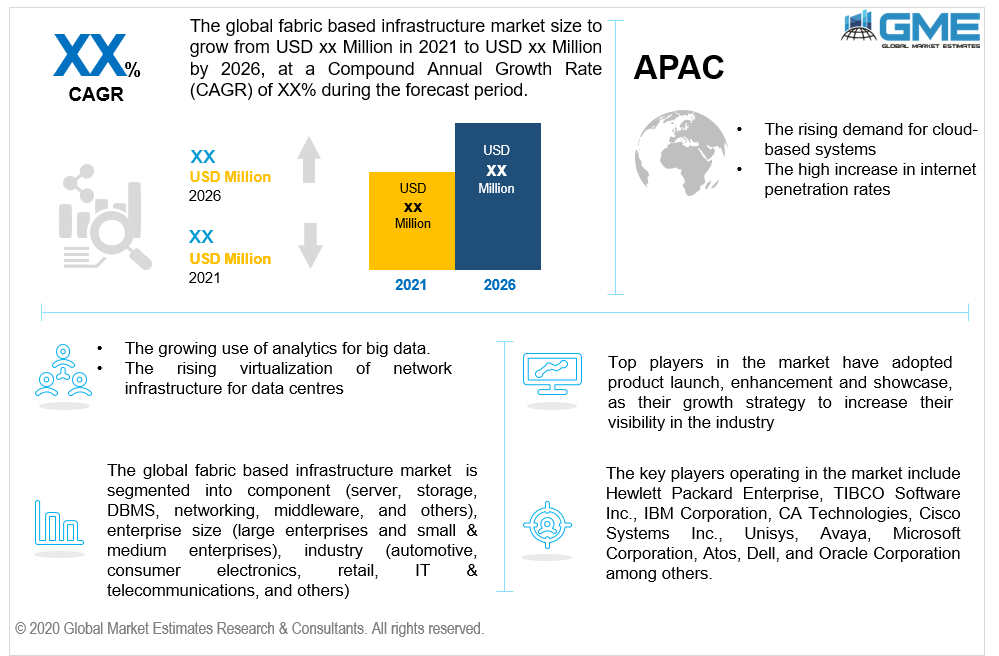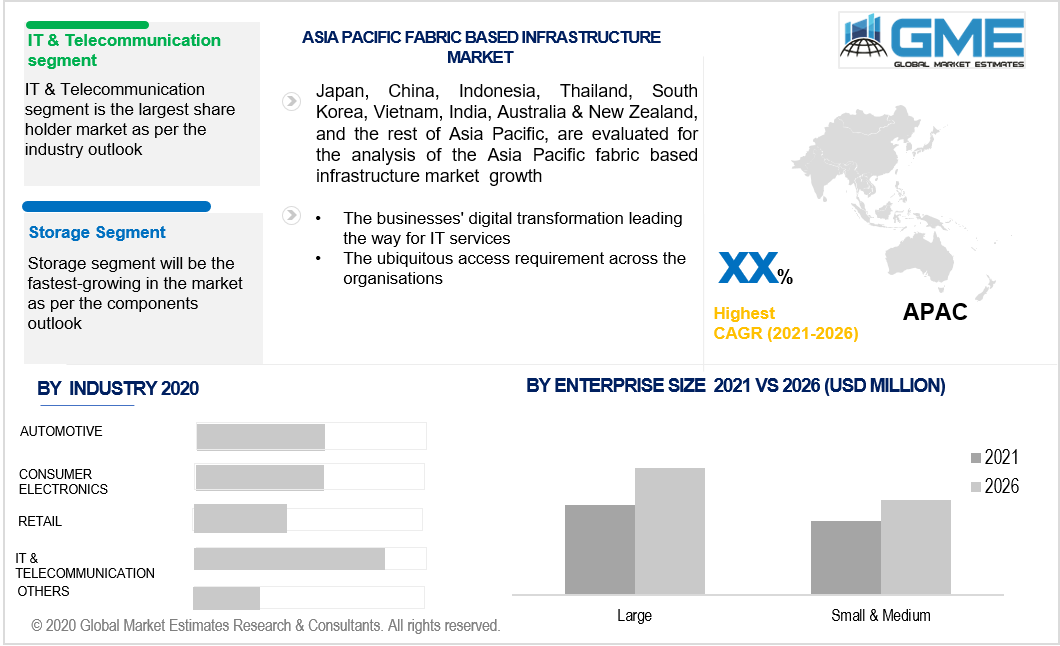
Fabric Based Infrastructure Market Size, Trends & Analysis - Forecasts to 2026 By Component (Server, Storage, DBMS, Networking, Middleware, and Others), By Enterprise Size (Large Enterprises and Small & Medium Enterprises), By Industry (Automotive, Consumer Electronics, Retail, IT & Telecommunications, and Others), By Region (North America, Europe, Asia Pacific, Middle East & Africa, and Central and South America), End-User Landscape, Company Market Share Analysis & Competitor Analysis
The rising virtualization of network infrastructure for data centers worldwide is helping the market of fabric-based infrastructure. The global fabric-based infrastructure market will propel with a peak CAGR between 2021-2026.
The fabric-based infrastructure is a method that, through combining hardware and software infrastructures, provides an integrated data center solution. Fabric-based infrastructure aims to provide a dynamically provisioned, managed, and automated real-time data center infrastructure. The need for fabric-based infrastructure is growing, due to the ability to reconfigure dynamically and flexibly. and provides parallel processing services.
The fabric-based infrastructure distinguishes from fabric-based computing by allowing existing technology elements to be clustered and bundled in a fabric-enabled development to ensure a modicum of infrastructure convergence. There are few advantages that the fabric-based infrastructure provides which are helping the market to grow which are bandwidth optimization, failover times improvement, and network topology simplification.
The growing adoption and implementation of cloud-based services among end-use industries are supporting the market growth. The shrinking IT budgets around organizations also act as a challenge for people to maintain data with less money in hand, and the search for alternatives due to this shrink can benefit the fabric-based infrastructure market enormously.
In a busy world, time always will be limited and this demands rapid and fluid response cloud services to react to corporate needs. Typically, IT takes a calculated approach to improve the IT infrastructure of an enterprise. When these systems are standing up, it is not just the technical information, management and teamwork involved, it is also the degree of reliability, scalability, and security they require.
The rising digitalization of businesses cannot be ignored in the digital era. In 2019, the percentage of businesses transforming to digital businesses was approximately 60-65, which in turn boosts the related markets to digitalization and one of them is the fabric-based infrastructure market.

The storage segment is estimated to be the fastest-growing segment in the fabric-based infrastructure market. The storage is a big issue for various reasons such as data center owners being forced to improve their data storage capacity, and managing within the shrinking IT budgets.
The Digital era demands more storage space as the information getting extracted and stored daily is increasing which hyped the demand for cloud technology. This cycle of innovation and development moves with new ideas to improve the data center solution.
Servers are a critical part of the growth strategy of any company. The business relies on a lot of variables for its performance. Some of those tools are internal, such as storing the right goods and recruiting the best individuals. The growth of this segment is expected to be decent encouraging the fabric-based infrastructure market to expand.
The large shareholder segment in the fabric-based infrastructure market is expected to be the large enterprises' segment. Large organizations require an infrastructure that can support their data size and complex structure by offering parallel processing services, which can be defined as a series of techniques that allow the system to accomplish data-processing tasks simultaneously to increase a computer system's computational speed.
The need for fabric-based infrastructure is supported by the need for having dynamic as well as versatile capabilities for reconfiguration, the increasing need for cloud technology, and the ability to scale robustly by the large enterprises.
The dominating segment in the market of fabric-based infrastructure is estimated to be the IT & telecommunication segment. The growth of next-generation IT enterprises is continuously leading to affordable yet reliable solutions for data handling, ubiquitous access requirement, rapid and fluid response expectations, the rising virtualization of network infrastructure for data centers, and the dependency of the modern era on IT services.
An organization, whether a small start-up or established company, facing slower growth during a crisis, can minimize operational costs, boost margins and unlock unexploited profits through better use of data and resources with AI, IoT, and automation skills tools. This feature of IT services encourages businesses to adapt better and secure infrastructures.
For automotive companies, technological innovation remains high on the list, but the data-accessing war is intense. Today's automotive industry operates on data from automotive design to manufacturing. But, if it is not linked and available, it is difficult for operations to run effectively. Due to which the market of fabric-based infrastructure is getting a grip on the automotive industry slowly.

The Asia Pacific and Europe regions are estimated to be the rapidly growing region for the fabric-based infrastructure market because of the demand in various countries such as China, Germany, India, Japan, and the UK for cloud-based systems and big data analytics technologies which is the need of the digital era.
The rise in the number of smartphones and tablets and the high increase in internet penetration rates which are positively impacting the market of the Asia Pacific region can also not be ignored as these factors lead to increasing demand for data storage and server.
North America is expected to be the dominating region for the market since the revolutionary technologies were implemented earlier and the involvement of numerous main players in the field.
Hewlett Packard Enterprise, TIBCO Software Inc., IBM Corporation, CA Technologies, Cisco Systems Inc., Unisys, Avaya, Microsoft Corporation, Atos, Dell, and Oracle Corporation among others are few major market players in the fabric-based infrastructure market.
Please note: This is not an exhaustive list of companies profiled in the report.
In May 2020: Dell Technologies and Google Cloud have collaborated to develop a new hybrid cloud storage infrastructure. The new hybrid cloud storage can handle 50 petabytes of high-performance workloads.
In February 2021: Ordr and Fortinet signed a collaboration agreement to provide advanced integrated solutions to handle security challenges caused by unmanaged devices and IoT.
We value your investment and offer free customization with every report to fulfil your exact research needs.
The Global Fabric Based Infrastructure Market has been studied from the year 2019 till 2026. However, the CAGR provided in the report is from the year 2021 to 2026. The research methodology involved three stages: Desk research, Primary research, and Analysis & Output from the entire research process.

The desk research involved a robust background study which meant referring to paid and unpaid databases to understand the market dynamics; mapping contracts from press releases; identifying the key players in the market, studying their product portfolio, competition level, annual reports/SEC filings & investor presentations; and learning the demand and supply-side analysis for the Fabric Based Infrastructure Market.

The primary research activity included telephonic conversations with more than 50 tier 1 industry consultants, distributors, and end-use product manufacturers.

Finally, based on the above thorough research process, an in-depth analysis was carried out considering the following aspects: market attractiveness, current & future market trends, market share analysis, SWOT analysis of the company and customer analytics.

Tailor made solutions just for you
80% of our clients seek made-to-order reports. How do you want us to tailor yours?
OUR CLIENTS